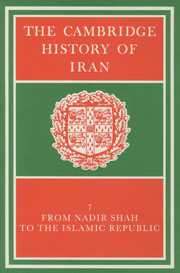Book contents
- Frontmatter
- PART 1 THE POLITICAL FRAMEWORK, 1722–1979
- PART 2 FOREIGN RELATIONS
- PART 3 ECONOMIC AND SOCIAL DEVELOPMENTS
- 13 LAND TENURE AND REVENUE ADMINISTRATION IN THE NINETEENTH CENTURY
- 14 THE TRIBES IN EIGHTEENTH- AND NINETEENTH-CENTURY IRAN
- 15 THE TRADITIONAL IRANIAN CITY IN THE QāJāR PERIOD
- 16 EUROPEAN ECONOMIC PENETRATION, 1872–1921
- 17 ECONOMIC EVELOPMENT, 1921–1979
- 18 THE IRANIAN OIL INDUSTRY
- PART 4 RELIGIOUS AND CULTURAL LIFE, 1721–1979
- Genealogical tables
- Bibliographies
- Index
- References
14 - THE TRIBES IN EIGHTEENTH- AND NINETEENTH-CENTURY IRAN
from PART 3 - ECONOMIC AND SOCIAL DEVELOPMENTS
Published online by Cambridge University Press: 28 March 2008
- Frontmatter
- PART 1 THE POLITICAL FRAMEWORK, 1722–1979
- PART 2 FOREIGN RELATIONS
- PART 3 ECONOMIC AND SOCIAL DEVELOPMENTS
- 13 LAND TENURE AND REVENUE ADMINISTRATION IN THE NINETEENTH CENTURY
- 14 THE TRIBES IN EIGHTEENTH- AND NINETEENTH-CENTURY IRAN
- 15 THE TRADITIONAL IRANIAN CITY IN THE QāJāR PERIOD
- 16 EUROPEAN ECONOMIC PENETRATION, 1872–1921
- 17 ECONOMIC EVELOPMENT, 1921–1979
- 18 THE IRANIAN OIL INDUSTRY
- PART 4 RELIGIOUS AND CULTURAL LIFE, 1721–1979
- Genealogical tables
- Bibliographies
- Index
- References
Summary
The contemporary social organization of individual tribal groups in Iran has recently been the focus of some detailed studies. Historical studies of the tribes have been few, however, and research into their social history has hardly begun. The available source material for such a social history is mostly written from a distance, by outsiders viewing the tribes with hostility or some other bias. For example, the information on the tribes that can be gleaned from sources such as Persian court chronicles, manuals and local histories, and from European agents' and travellers' reports, largely concerns such matters as taxation, military contingents, disturbances and measures taken to quell them, and inaccurate lists of major tribal groups, numbers and leaders. Economic and social organization are treated superficially if at all, and even for the last two centuries their basic features must be inferred circumstantially or deduced from later, more complete studies.
This chapter gives in the first instance a general survey, based on available source materials, of the distribution of the tribes and their political history as a “problem” for the Iranian government in the 18th and 19th centuries. The second part of the chapter attempts an analysis, on the one hand, of the processes of ecological adaptation and social and economic organization which may be considered to have contributed to the “tribal problem”, and, on the other, of the development of different tribal groups during the period as the product of interaction between these various kinds of processes: ecological, economic, social and political.
- Type
- Chapter
- Information
- The Cambridge History of Iran , pp. 506 - 541Publisher: Cambridge University PressPrint publication year: 1991

